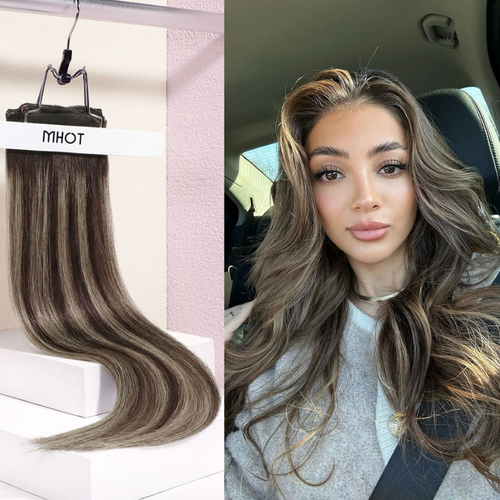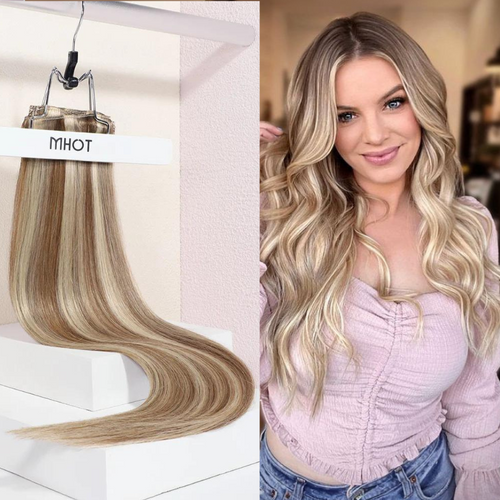I. Introduction
A. Definition of Human Hair and Synthetic Extensions: Hair extensions are strands of hair that are attached to a person's natural hair to add length, volume, or color. Human hair extensions are made from real human hair collected from donors, while synthetic hair extensions are made from synthetic fibers designed to mimic the look and feel of natural hair.
B. Importance of Understanding the Differences: Choosing between human hair and synthetic extensions can significantly impact your styling options, maintenance routine, and overall satisfaction with the extensions. Understanding the key differences between these materials is crucial for making an informed decision that aligns with your preferences, budget, and lifestyle.
C. Preview of Topics to be Discussed: In this comprehensive guide, we'll explore the characteristics, benefits, and considerations of human hair and synthetic extensions. From material composition to maintenance requirements, we'll delve into everything you need to know to choose the right extensions for your needs.
II. Human Hair Extensions: Characteristics and Benefits
A. Overview of Human Hair Extensions: Human hair extensions are prized for their natural appearance and texture, as they are made from real human hair collected from donors. This results in extensions that look and feel remarkably similar to natural hair, making them a popular choice among extension wearers.
B. Natural Appearance and Texture: One of the primary benefits of human hair extensions is their ability to blend seamlessly with natural hair. Because they are made from real human hair, they have a natural appearance and texture that closely resembles that of the wearer's own hair. This makes it easier to achieve a flawless, undetectable look when wearing human hair extensions.
C. Versatility in Styling Options: Another advantage of human hair extensions is their versatility in styling options. Human hair can be heat-styled, colored, and treated just like natural hair, allowing for endless possibilities when it comes to creating different looks and styles. Whether you prefer sleek and straight or voluminous curls, human hair extensions can be styled to suit your individual preferences.
D. Longevity and Durability: With proper care and maintenance, human hair extensions can last for a year or more, making them a long-term investment for extension wearers. Because they are made from real human hair, they are more durable and resistant to damage than synthetic extensions, allowing them to withstand regular washing, styling, and heat exposure without losing their quality or integrity.

III. Synthetic Hair Extensions: Characteristics and Benefits
A. Overview of Synthetic Hair Extensions: Synthetic hair extensions are made from synthetic fibers designed to mimic the look and feel of natural hair. These fibers are manufactured using advanced technology to create extensions that are lightweight, durable, and affordable.
B. Synthetic Fibers and Manufacturing Process: Synthetic hair extensions are made from synthetic fibers such as polyester, acrylic, or polypropylene. These fibers are processed and treated to resemble natural hair, with options available in a variety of colors, textures, and styles. The manufacturing process allows for greater consistency in color and texture, making synthetic extensions an attractive option for those looking for pre-styled options.
C. Affordability and Accessibility: One of the main benefits of synthetic hair extensions is their affordability and accessibility. Synthetic extensions are typically more budget-friendly than human hair extensions, making them a popular choice for those on a tight budget or looking for a temporary hair transformation. Additionally, synthetic extensions are readily available at beauty supply stores, online retailers, and salons, making them easily accessible to extension wearers.
D. Low Maintenance and Pre-Styled Options: Synthetic hair extensions require minimal maintenance compared to human hair extensions, making them an attractive option for those with busy lifestyles or limited styling skills. Because synthetic extensions are pre-styled, they retain their shape and texture even after washing, allowing for effortless styling and maintenance. This makes them an ideal choice for those looking for a low-maintenance hair extension option.

IV. Key Differences Between Human Hair and Synthetic Extensions
A. Material Composition: The primary difference between human hair and synthetic extensions is the material composition. Human hair extensions are made from real human hair collected from donors, while synthetic extensions are made from synthetic fibers designed to mimic the look and feel of natural hair. This difference in material composition affects the appearance, texture, and styling options of the extensions.
B. Appearance and Texture: Human hair extensions have a natural appearance and texture that closely resembles that of the wearer's own hair. They blend seamlessly with natural hair and can be styled, colored, and treated just like natural hair. In contrast, synthetic extensions may have a shinier, more artificial appearance and texture that can be less natural-looking than human hair extensions.
C. Heat Styling Capabilities: One of the key differences between human hair and synthetic extensions is their heat styling capabilities. Human hair extensions can be heat-styled, colored, and treated just like natural hair, allowing for endless styling options. In contrast, synthetic extensions are not heat-resistant and can be damaged or melted by heat styling tools such as flat irons, curling irons, and blow dryers.
D. Longevity and Maintenance Requirements: Human hair extensions tend to have a longer lifespan and require more maintenance than synthetic extensions. With proper care and maintenance, human hair extensions can last for a year or more, while synthetic extensions typically last for a few months. Additionally, human hair extensions require regular washing, conditioning, and styling to maintain their quality and integrity, while synthetic extensions require minimal maintenance and retain their shape and texture even after washing.

V. Suitability for Different Hair Types and Lifestyles
A. Considerations for Natural Hair Types: When choosing between human hair and synthetic extensions, it's essential to consider your natural hair type and texture. Human hair extensions are suitable for all hair types and textures, from straight and fine to curly and coarse, making them a versatile option for extension wearers. In contrast, synthetic extensions may be less suitable for those with very fine or fragile hair, as the weight of the extensions can cause breakage or damage.
B. Lifestyle Factors Influencing Extension Choice: Your lifestyle can also influence your choice between human hair and synthetic extensions. If you lead an active lifestyle or frequently participate in activities such as swimming, exercising, or traveling, synthetic extensions may be a more practical option due to their low maintenance and durability. However, if you prefer a more natural look and feel or want the flexibility to heat-style your extensions, human hair extensions may be a better choice.
C. Matching Extensions to Individual Preferences and Needs: Ultimately, the best choice between human hair and synthetic extensions depends on your individual preferences, needs, and budget. If you're looking for a long-term investment with maximum versatility and styling options, human hair extensions may be the way to go. However, if you're on a budget or looking for a temporary hair transformation, synthetic extensions may be a more practical option.
VI. Tips for Choosing the Right Extensions
A. Factors to Consider When Selecting Extensions: When choosing between human hair and synthetic extensions, there are several factors to consider, including material composition, appearance, texture, heat styling capabilities, longevity, and maintenance requirements. Take the time to research and compare different options to find the extensions that best meet your preferences and needs.
B. Consultation with a Hairstylist or Extension Specialist: Consider consulting
with a hairstylist or extension specialist for personalized recommendations and advice. They can assess your natural hair type, texture, and color to recommend the most suitable extension options for a seamless blend and natural-looking finish.
C. Budget Considerations and Long-Term Investment: Before making a decision, consider your budget and long-term investment goals. Human hair extensions tend to be more expensive upfront but offer greater durability and longevity, making them a worthwhile investment for those looking for a long-term solution. Synthetic extensions, on the other hand, are more budget-friendly but may need to be replaced more frequently, depending on your styling habits and maintenance routine.
VII. Maintenance and Care for Human Hair Extensions
A. Washing and Conditioning Routines: Human hair extensions require regular washing and conditioning to maintain their quality and integrity. Use a gentle sulfate-free shampoo and conditioner to cleanse the extensions, avoiding harsh chemicals or products that can strip the hair of its natural oils. Be sure to rinse the extensions thoroughly to remove any residue, and gently pat them dry with a towel to avoid tangles or damage.
B. Heat Styling Techniques and Precautions: Human hair extensions can be heat-styled, colored, and treated just like natural hair. However, it's essential to use heat styling tools responsibly and apply a heat protectant spray or serum before using hot tools to prevent damage. Avoid using excessive heat or styling products near the attachment points of the extensions, as this can weaken the adhesive bond and cause the extensions to slip or become dislodged.
C. Storage and Protection When Not in Use: When not wearing your human hair extensions, store them in a clean, dry place away from direct sunlight or heat sources. Avoid folding or bending the extensions, as this can cause creasing or breakage, and instead, lay them flat or hang them using a clip-in extension hanger. Be sure to gently comb through the extensions before storing them to remove any tangles or knots, and avoid overcrowding them to maintain their shape and quality.
VIII. Maintenance and Care for Synthetic Hair Extensions
A. Cleaning and Detangling Methods: Synthetic hair extensions require minimal maintenance compared to human hair extensions. To clean synthetic extensions, gently wash them with a mild shampoo and lukewarm water, being careful not to rub or agitate the fibers too vigorously. Avoid using hot water or excessive heat when washing synthetic extensions, as this can cause the fibers to melt or become distorted. After washing, gently pat the extensions dry with a towel and allow them to air dry completely before styling.
B. Avoiding Heat Exposure and Styling Precautions: Unlike human hair extensions, synthetic extensions are not heat-resistant and can be damaged or melted by heat styling tools. Avoid using flat irons, curling irons, or blow dryers on synthetic extensions, as this can cause irreparable damage to the fibers. Instead, opt for heat-free styling techniques such as air drying or wet setting to achieve your desired look without risking damage to the extensions.
C. Storage Tips to Preserve the Lifespan of Synthetic Extensions: When not in use, store synthetic extensions in a cool, dry place away from direct sunlight or heat sources. Avoid storing them near sources of moisture or humidity, as this can cause the fibers to become frizzy or tangled. Use a breathable storage bag or pouch to protect the extensions from dust and debris, and avoid overcrowding them to maintain their shape and quality.
IX. Benefits and Considerations of Each Material
A. Advantages of Human Hair Extensions:
- Natural appearance and texture
- Versatility in styling options
- Longevity and durability with proper care
B. Advantages of Synthetic Hair Extensions:
- Affordability and accessibility
- Low maintenance and pre-styled options
- Consistent color and texture
C. Potential Drawbacks and Limitations of Each Material:
- Human hair extensions can be more expensive upfront and require more maintenance
- Synthetic hair extensions may have a shinier, more artificial appearance and are not heat-resistant
X. Conclusion
Understanding the differences between human hair and synthetic extensions is essential for choosing the right option for your needs and preferences. Whether you prioritize natural appearance and versatility or affordability and low maintenance, there are pros and cons to consider with each material. By weighing these factors and following a proper maintenance routine, you can enjoy beautiful, long-lasting extensions that enhance your natural beauty and style.


